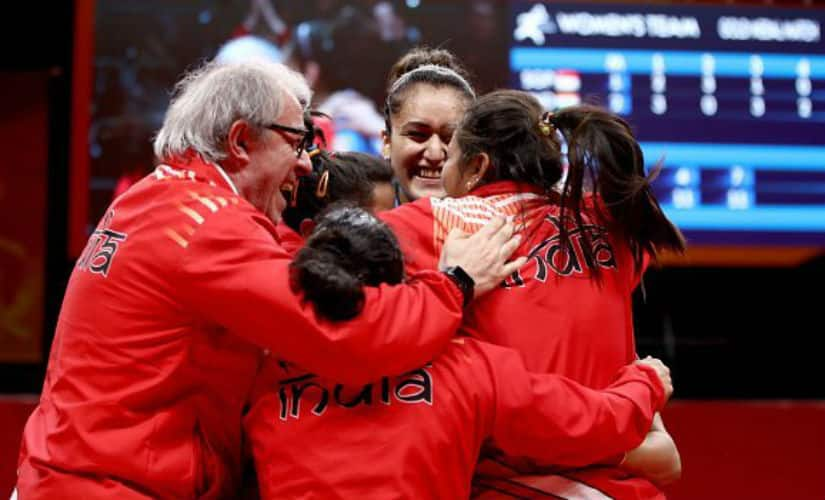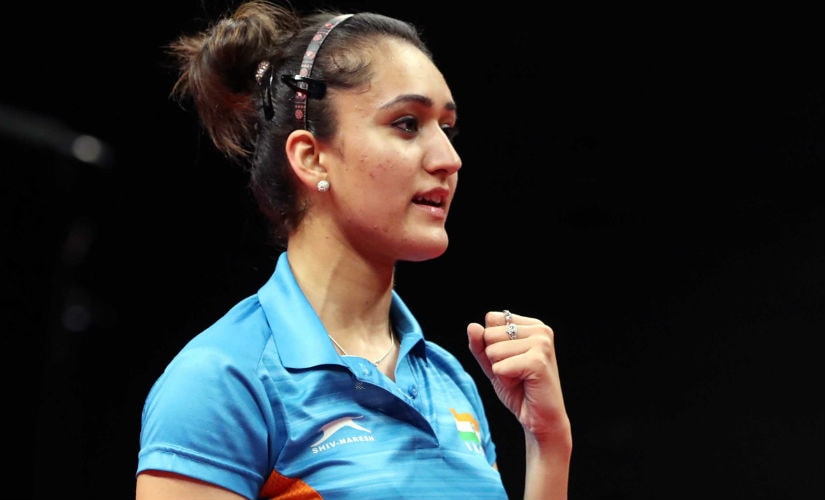Even as the ball was still in mid-air off a defensive chop from Zhou Yihan, Manika Batra had erupted in celebration. A simple one, just like her soft-spoken shy personality – two arms raised and that quintessential, charming smile with a bevy of emotions, that of disbelief, relief and satisfaction, circulating inside her mind. Even before the realisation had struck, she was swamped by her charging teammates and coach, who jumped the hoardings and burst into a huddle at the Oxenfort Studios arena in Gold Coast. Yihan had hit the ball long and the Indian women’s table tennis team had done the unthinkable – beaten the fire-breathing dragon of Singapore. Unthinkable because this team had achieved what no other team could in the last four editions – beat Singapore women’s team in a gold medal match at the Commonwealth Games. Singapore women’s team had clinched all four golds since 2002. No one had given India a chance going into the final against the top-seeded side. Even before the start of the Games, the talk was about bringing home the silver. It was a rematch of the 2010 Delhi Games women’s team final but in a dramatic turnaround, this time the script had changed. A monumental effort in Gold Coast had produced a historic achievement mainly due to meticulous planning and perfect execution. The women’s team led by coach Massimo Costantini, had developed a sound strategy. “Singapore (are) used to playing extremely fast balls,” Costantini told Firstpost “Our job was to create some of sort of interference in that speed by playing some soft balls, dead balls, spinny balls, everything but speed and it paid off.” [caption id=“attachment_4423901” align=“alignnone” width=“825”]  Indian women’s table tennis team celebrate their win against Singapore. Image Courtesy: Twitter @ioaindia[/caption] Batra, the highest ranked Indian women’s paddler in the world (58) was the pivot around which the team revolved. Batra’s two singles matches were crucial to India’s chances, especially with her rare style of play. Batra uses long pimples on the backhand side which is a defensive setup; she can slow down the game and break an opponent’s rhythm. However, she has also learnt to use it as an attacking weapon. The twiddle of her racquet confuses the opponent. It is this mix of attack and defense that helped her pull off a heist with a stunning win over World No 4 and three-time Olympic medallist Tianwei Feng in the first rubber, her best ever win so far in her career. “I knew that she (Feng) was having problems with my pimpled rubber and I realised that but I did not use it as my strength all the time. I kept changing my game. I did not want to keep her settled so I changed my rubber after the second game,” Batra told PTI. Former India paddler and Olympian Neha Aggarwal possessed a similar style of play as Batra and she further explains how Batra outsmarted Feng. “She was very confident in her attack from her backhand and forehand side,” Aggarwal tells Firstpost. “Her forehand has been her weak point but today (Sunday) the forehand was very, very strong. She was like a wall, I can’t remember a time when she missed the ball from her backhand side. So the overall game was very consistent today. It was a good mix of attack and defense.” It’s one thing to develop strategies off-court and another to implement them during the match. The Indian girls, led by Batra, executed the plans to perfection. Batra was 2-1 down in the first rubber but came back to win 3-2. Madhurika Patkar suffered a hard-hitting defeat in the second singles rubber against Mengyu Yu but that didn’t affect her performance in the doubles rubber with Mouma Das, where the pair snapped up an extremely crucial win. They kept putting pressure back on the Singapore girls. Somewhere down the line this ability to bounce back stemmed from the self belief. “Yes, of course we believed that we could win against Singapore,” Mouma Das tells Firstpost. The way we were playing in the team events right from the first round, we were sure of giving a spectacular performance in the final. Our biggest strength behind our gold medal win was team spirit, hard works and above all, belief,” she adds. “Today (Sunday) the girls believed in themselves, because the first match was on their side, the Singaporeans were so much under pressure and they couldn’t take that pressure. The Indians had nothing to lose,” says Aggarwal.
Along with self belief there was that extra bit of confidence injected by the coaches Costantini and Soumyadeep Roy. The duo inspired the team with motivational words in the pre-match meeting and Constantini also brought up the example of the 2010 World Championships final where Singapore beat table tennis powerhouse China to shock the entire table tennis world.
“I also told them that to do something special you have to do something extraordinary,” Constantini says. And he kept repeating these words throughout the match. “During the meeting the coaches told us to play the best table tennis of our lives, to create history and become heroes. These words motivated us a lot,” Das explains. While Batra’s first rubber win laid the platform and instilled momentum, India were pegged back in the second with Patkar’s loss. Patkar was impressive against England in the semi-final earlier in the day and needed to rejuvenate quickly for the doubles rubber. In the past, she would have wilted under pressure but here she was a changed player. The 30-year-old regained her focus back and it was her aggressive play coupled with a strong back-hand that did the damage on the opponents in the doubles. Generally it’s the pair of Manika-Mouma that plays the doubles. They are the top seed in the tournament but with one player allowed to play just two games, India had to build their strategy around Batra as singles specialist. So the Madhurika-Mouma pair was formed with Pooja Sahasrabuddhe, Suthirta Mukherjee being relatively inexperienced. It took some time for the duo to get into the groove. They lost their doubles match against Wales but with constant practice they gelled together in short time and won their next two rubbers, against Malaysia and England. They went one step further and pulled off a coup by beating the formidable pair of Zhou Yihan and Mengyu Yu in the gold medal match. [caption id=“attachment_4423913” align=“alignnone” width=“825”]  Manika Batra reacts after winning a point in the women’s gold medal match against Singapore. Reuters[/caption] “This pair improved day by day,” says Constantini. “Initially they were kind of rusty, the automatism of play was not fluid, but by playing and playing they got the proper feeling, understanding and chemistry and they made their masterpiece by winning against the strong pair from Singapore.” The duo formed an aggressive combo with a similar style of attacking play. Madhurika’s strong backhand was complemented by Mouma’s powerful forehand. The pair also troubled the Singapore girls with their serves, especially the backhand ones as they won 21 points out of the 41 on the serve. They also had luck going their way with a few net points. “Keep attacking was our only strategy,” says Das. I and Madhurika have a good rapport and understanding which is very important for the doubles,” the veteran added. “Even now Mouma and Madhurika don’t believe in what they have just done,” Costantini quips. Batra came back and applied finishing touches by beating Yihan in the reverse singles in the fourth rubber to send the Indian fans and the team into raptures. Tears rolled down as the national anthem was belted out. On a historic day in Indian table tennis, by ending Singapore’s domination, the women paddlers had indeed done something special as well as extraordinary. A win that will “leave behind a legacy for future generations,” in Constantini’s words. “It (gold medal win) means the world. It means everything,” says Aggarwal. “Nobody had the belief in the Indian women’s team. This win will put Indian table tennis on world map. It was a world class performance that too under pressure situation.” “It has opened so many new doors in Indian table tennis for women because it has always been about the men. I am a big fan of Sharath Kamal and I really like the men and the way they are playing. But Indian table tennis was never about women. It was always said that the women don’t go out and play, they have not been stepping out of their comfort zone, and they have just been focusing on the Indian national circuit and all that. But today they proved themselves,”Aggarwal added. And indeed proved themselves in style with a win over the giants of Singapore. This is now a team of champions not pushovers.


)

)
)
)
)
)
)
)
)



